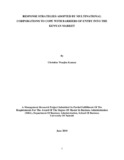| dc.description.abstract | In most major economies of the world, the significance of domestic and foreign-based multinational corporations is increasing. Such corporations, directly or indirectly, account for a large part of the world trade in goods and services (Nilsson, Dickens 1996). Despite their reasons of going international, when entering foreign markets, Multi-National Corporations (MNCs) may face certain barriers and challenges from the host country's policies, systems, rules, regulations and general business environment. Entry barriers are present to protect domestic industry or to ensure that companies entering from foreign markets conform to trade relation's arrangements with other countries.
Given the regulated environment that MNCs may operate under, response strategies are therefore necessary for MNCs in order to meet these challenges of barriers to entry. This therefore provides alternatives of direct investment, licensing of a local firm, use of a turnkey venture or some other organizational strategy that employs local production. Despite the advancements made by Kenya in attracting foreign investment through the MNCs, they still face both formal and informal barriers to trade and investment. These barriers range from trade and investment in terms of rules and regulation, political turbulence, corruption, lobbying by local competitors, unfavorable business environments that add to the operating costs of firms and other nuances affect their operations.
This study sought to identify the specific barriers to trade and investment that MNCs in Kenya face when carrying out their business operations in the Kenyan market and establis!l strategies that they use to deal with these barriers. Various groups will benefit from this study. These include the academicians, MNCS and the Government of Kenya. The population of the study was all MNCs from various countries of origin i.e. USA, Europe and Middle East that operate in Kenya. A total of 53 MNCs operating in Kenya were targeted for this study.
The questionnaire used was divided into three different parts and was structured to address the various research objectives of the study. Section A of the questionnaire dealt with the profile of the Multinational Corporations. Part B addressed the· entry barriers that MNCs face in Kenya and Part C sought to determine the response strategies adopted by MNCs in Kenya to cope with the entry barriers.
The questionnaires were administered on the basis of 'drop and pick later' or picked immediately depending on the availability of the respondents and where direct access was not possible the questionnaire were sent via e-mail. The questionnaires were dropped to the target respondents with an introductory letter: To enhance high response rate, the researcher made telephone follow ups with the targeted respondents. Data analysis was carried out using Statistical Package for Social Sciences (SPSS) and Micro Soft Excel. The coding was done in such a way that a data matrix was easily created by SPPS. Descriptive statistics using Measures of Central Tendency (mean, standard deviation and frequencies) were used in the final reporting. Overall it was noted that MNCs face a number of barriers though to varying degrees. All the policy barriers that wete considered except two presented the greatest barriers in entry of MNCs to the country. Monetary policies pose the greatest barrier followed by regulations and controls, trade policies, fiscal policies and financial sector policies. Only labor law policies presented the least barrier to the MNts entering Kenya. In regard to response strategies, it was noted that four strategies are greatly used. These strategies greatly used by the MNCs to cope with the entry barriers include localization of operations, lobbying relevant stakeholders, establishing wholly - owned subsidiaries in the host country and licensing. Only one response strategy was least used, this was indirect exporting. Areas recommended for further include a study of Kenyan MNCs and the response strategies they employ to cope with barriers of entry into the regional market. Another one is to study the determine the exit barriers MNCs face when leaving the Kenyan market and the strategies they employ to cope with the same | en_US |

